
"To get around these limitations, F1 built several internal prediction models based on past seasons' GPS data and lidar scans of each track. It then integrated those models into an in-house application that overlayed a synchronized video feed of those same past qualifying trials, then compared the two data inputs side by side. By first manually identifying discrepancies where GPS data from qualifying clearly was out of whack based on video footage,"
"A drawback, though: F1 can't yet show its ghost car on live broadcasts. Because the team's process still requires that final bit of manual fine-tuning to ensure the translucent ghost car is positioned accuracy, Locke says it takes around 90 minutes to pass the ghost car overlay to broadcast partners after each qualifying run. The team's goal is a 30-minute turnaround to facilitate quicker post-qualifying analysis."
Urban circuits such as Monaco, Baku and Singapore produce GPS drift because dense infrastructure and buildings disrupt satellite signals, while F1 cars' lighter weight requires lower-weight sensors that complicate telemetry. F1 developed internal prediction models using past seasons' GPS data and lidar scans, and integrated them into an in-house application that overlays synchronized video of past qualifying trials and compares data side-by-side. Manual identification of discrepancies helped train the models to spot anomalies and correct GPS errors. The ghost car feature launched for the 2025 season with in-car and helicopter views. Live overlays remain unavailable due to manual fine-tuning that currently takes around 90 minutes; the goal is 30 minutes. Ghost car clips have been popular on social channels, and IndyCar broadcasters have pushed similar single-car coverage innovations.
Read at WIRED
Unable to calculate read time
Collection
[
|
...
]